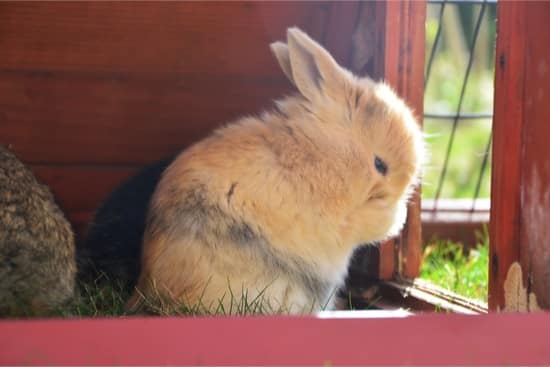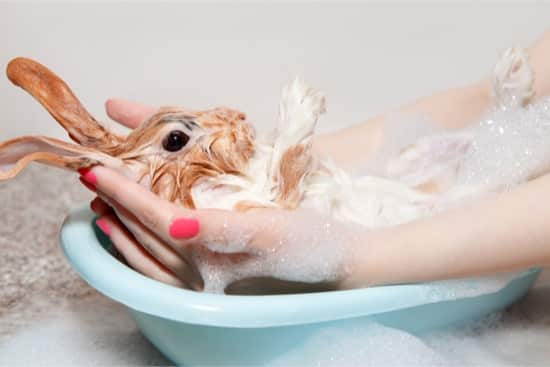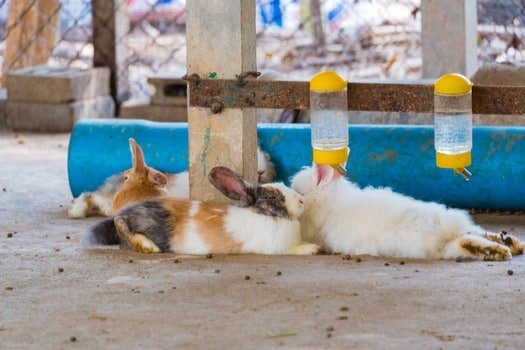Some rabbits sit in their litter boxes after they’ve finished urinating. We don’t know why they do this, but it’s a common behavior in domestic rabbits. Sadly, this can cause rabbit fur to turn yellow.
The most effective way to remove yellow urine stains on rabbits is to rub corn flour powder into the fur and tease the fur gently with a comb. If the fur is urine-soaked and smells of ammonia, your rabbit will need a wet bath. This can be performed at home or by a vet.
Rabbits with slightly yellow feet don’t usually need to be washed. Instead, you should encourage good self-cleaning habits. In this guide, we’ll explain how to get rid of urine stains on rabbit fur and feet. We’ll then advise on how to prevent yellow fur due to urine from returning in the future.
Has Urine Stained My Rabbit’s Feet?
If the fur on your rabbit’s feet has changed color, this could be due to:
- Urine staining or urine scalding
- Rust stains from the cage
- Ink/color running from the litter (i.e., newspaper print)
- Dust and dirt – more likely if your rabbit has an outdoor hutch/run
In some cases, the color change might not even be a stain. Rabbits molt regularly and sometimes the fur underneath is a different color. However, if you see localized patches of yellow/dark fur only around the feet and underside, this probably is a stain of some sort.
Why Do Rabbits Have Discolored Feet?
If your rabbit’s feet are turning yellow, this is probably due to urine staining. Rabbits produce a lot of urine, especially during the summer months because they tend to drink more water.
Some rabbits tend to sit in the litter pan after they’ve finished urinating. This is especially common in younger rabbits. This behavior can cause the pads of the feet to become slightly yellow.
Also, some rabbits’ fur may become stained if they can’t urinate properly or if they can’t clean themselves properly. In these cases, the pads of the feet, the inside of the hind legs, and the bottom of the belly may start to turn yellow.

Are Yellow Rabbit Feet a Cause for Concern?
Rabbits are difficult to keep in pristine condition, so some yellowing of the feet is not necessarily anything to worry about. If the yellowing is localized to the pads of the feet, you should be less concerned (as long as there are no mats or skin lesions on the bottom of the feet).
However, if the rabbit’s underside has become yellow, matted, damp and/or smelly, this is more serious, and you will need to intervene. A yellow, damp, and smelly underside can be caused by:
Urinary Problems
If your rabbit is urinating more often than usual, or urinating clumsily, they may have a urinary condition.
Kidney problems, bladder infections, urinary tract infections or urolithiasis (sludgy urine caused by a high-calcium diet) could be to blame. Urinary conditions will most likely lead to urine scalding.
Urine Scalding
This occurs when the inside of the rabbit’s hind legs become red and sore.
The fur may also be urine-soaked and smelly. Urine scalding can lead to fly strike or other severe conditions if left untreated.
Aggressive House Guest
Male rabbits (unneutered) start spraying at a young age. If you have two unneutered rabbits living together, the dominant male may begin to spray the other rabbit, causing their fur to turn yellow.
Also, if two rabbits are sharing a small enclosure, one might end up hiding in the litter box to avoid the other. In general, though, neutered rabbits do better in pairs rather than alone.
Unsuitable Living Conditions
If the hutch is too small, your rabbit will find it hard to keep clean. As a result, the fur may become stained or matted.
So, yellow fur on the inside of the hind legs, and damp, sore-looking fur should be seen by a vet.
Can I Remove Urine Stains on Rabbits with a Bath?
If your rabbit’s fur is turning yellow, your first reaction might be to bath it. But is this the right thing to do? Healthy rabbits should not be bathed in water because they can clean themselves.
Also, most rabbits will get frightened when immersed in water, so the risk of injury often outweighs the benefits of cleaning the rabbit’s fur.
Bathing your rabbit may be necessary in some circumstances. A rabbit that is arthritic or immobile may not be able to lean over to groom herself, for example.
Also, if your rabbit has already developed urine scalding (sore, smelly fur on the inside of the hind legs), she will probably need a wet bath to prevent fly strike.
If your rabbit has minimal staining on the pads of her feet (and no damp, sore fur), a wet bath is unnecessary. In this case, you can leave the staining as it is, or give your rabbit a gentle, dry bath.
How to Clean a Rabbit’s Feet and Fur with a Dry Bath
Fur that is lightly stained can usually be treated with a dry bath. Most bunnies can tolerate a dry bath, but it’s important to be patient and gentle.
- Place your rabbit in a comfortable position. The easiest position for accessing the feet and underside is the belly-up position. If placing the rabbit in a belly-up position, make sure a soft, padded surface supports her back and neck. Do not force her to stay in this position if she tries to make a getaway.
- Take some Corn Starch Powder (baby care product) and apply this to any fur that is urine-stained. Do not use regular talcum powder or corn starch powder with added botanicals as this could irritate your rabbit.
- Rub the powder into the stained areas on the feet and inside the hind legs, if necessary. The powder will coat and help to lift the urine from the fur. At this point, you may choose to comb through the fur with a flea comb but be extremely careful not to pull too hard.
- Pat and stroke the fur until the powder has been removed. This will produce some powdered debris. Ideally, have someone vacuum it up with a hand-held vacuum immediately, so it does not irritate your bunny.
The powder should fall off your bunny quite easily. Try to make sure it has all gone before putting your rabbit back in her hutch.
How to Clean Urine from Rabbit Fur with a Wet Bath
If your rabbit has urine scalding on the inside of her legs, and her fur is damp and smelly, she would probably benefit from a wet bath.
According to Rabbit Welfare, rabbits can be bathed in the following way:
- Washing your rabbit in the sink is usually the easiest option.
- Fill the sink with a couple of inches of tepid-to-warm water (no more than 90 degrees Fahrenheit) and mix in a teaspoon of specialist rabbit shampoo.
- Ideally, have a second person hold the rabbit and hover her gently over water so that she is a few centimeters above the water. Gently rub the water/shampoo mix into the rabbit’s legs and undercarriage, creating a lather in the fur.
- If your rabbit tolerates it, you can submerge her legs into the water, so she is standing in the sink (while your helper still holds her). Some rabbits may not tolerate this and will need to be held above the water.
- Try to work quickly, but thoroughly.
- Once lathered up, take a jug of water and gently rinse off the shampoo suds.
- Once rinsed, towel dry your rabbit to stop her from getting cold. Be gentle when you rub. Microfiber towels are great for this purpose as they are very soft and absorbent.

Getting the technique right can be tricky. You need to work quickly to stop your rabbit from getting cold, but you also need to be gentle. Often, it is better for your vet to show you how to wash your rabbit, and then you can repeat this at home when necessary.
Should I Cut the Mats Out of My Rabbit’s Fur?
When giving your rabbit a dry or wet bath, you might come across some matted fur on the feet, hind legs, or underside. You should never attempt to cut these mats off yourself.
Rabbit skin is extremely delicate, so it would be easy to accidentally pierce the skin while attempting to cut a mat out. Also, rabbits can be extremely flighty so they could easily knock the scissors and cause a severe injury.
Mats can be teased out using the dry bath method, or by using a mat splitter or mat rake. If you are teasing mats out, hold the fur at the base of the strands, so you don’t end up pulling at the rabbit’s skin.
What Is Flystrike?
If your rabbit’s fur is urine-soaked, she could develop flystrike. This occurs when flies lay eggs on the damp, smelly coat. These eggs can hatch into maggots in as little as 2 hours. These maggots will then eat away at the rabbit’s flesh.
So, if your rabbit has urine-soaked fur and you are not confident in cleaning it yourself, you should keep her indoors and take her to the vet as soon as possible.
How to Prevent Urine Stains on Rabbit Fur
Keeping rabbits in pristine condition is hard. Nevertheless, there are some things you can do to prevent urine-stained fur. These include:
- Neuter your Rabbit – Although there are some risks involved in this procedure, neutering rabbits lengthens their life and improves their toileting behaviors. Neutered rabbits are less likely to spray or spend lots of time sitting in their litter box.
- Spacious Housing – Provide enough space for your rabbit to move around in and groom herself freely. If your rabbit lives in a hutch outside, try to attach the run to the hutch so your rabbit can come-and-go as she pleases. This will encourage her to stay clean and healthy.
- Reward Good Behavior – If you see your rabbit laying in the litter box, don’t shout at her. Instead, encourage her to sit elsewhere and provide a small treat to reward this behavior.
- Diet – Ensure your rabbit is getting a well-balanced diet and plenty of water. This will promote optimum urinary health.
Also, don’t forget to take your rabbit to the vet for regular check-ups. They’ll be able to spot the signs of any kidney or urinary problems that might lead to urine-stained fur.
How to Neutralize the Smell of Rabbit Urine
If your rabbit has urine-stained fur, she’s probably smelling a bit more than usual. The smell of rabbit urine is unpleasant, but it can also be potentially harmful to your rabbit if it is left to fester.
The ammonia in rabbit pee is what gives it its strong odor. Ammonia can be irritating for your rabbit’s nose and eyes, so it’s a good idea to eliminate this chemical. Here are a few tips:
- Choose the Right Litter – Opt for a litter that is “highly absorbent.” Paper pellets often work best for this purpose.
- Avoid Wooden Hutches – Pee absorbs into the wood and can rot the wood over time. It’s also tough to remove the smell of urine from wood.
- Wash with White Vinegar – The litter pan, and other detachable surfaces can be washed with white vinegar to help neutralize the odor of rabbit pee. It also helps to get rid of urine crystals.
Finally, make sure you are cleaning your rabbit’s hutch regularly.

